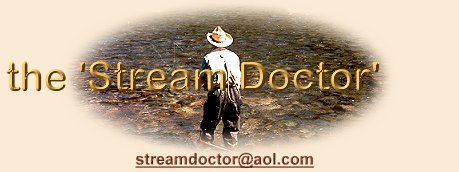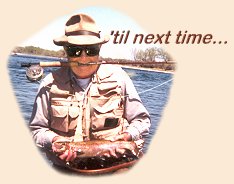
| ||
|
February 12th, 2006
|
|
Comments: Dear Mr. Cushing, I found the 2/5/07 article "Transplanting Insects?" on Fly Anglers Online very interesting. I would like to point out two things. First, the correct term is not "re-introduction" (a "reintroduction" is still an introduction) but "restoration." Second, there is an entire chapter dedicated to the issue of restoration of insects to streams, specifically the Eastern Green Drake, in NY Times writer George Black's 2004 book The Trout Pool Paradox: the American Lives of Three Rivers. The chapter describes an apparently successful effort to restore them to the Housatonic River in western Connecticut after an extremely damaging flood (in the '50s, I seem to recall) which temporarily wiped out the sandy bottoms needed by the nymphs. The chapter actually describes just how they accomplished that! I seem to remember reading that the volunteers carefully collecting the nymphs and placing them in buckets with the very same substrate from the location in the river where they were collected, buckets which were then dug in and placed in as identical conditions as possible in the Housatonic. The efforts, as I wrote, were apparently successful: the 1998 book Housatonic River: Fly Fishing Guide by Jeff Passante lists Eastern Green Drake as one of the hatches; my understanding is that there aren't many that hatch every year - certainly not as abundant as they were prior to the "great flood." Tight thread & line, Gian Andrea Morresi Fairfield, Connecticut
Responses: Dear Mr. Morresi:
Thanks for the information; it's good to know about the
efforts on the Housatonic. I notice that you use the
words "apparently successful" twice; I'd be curious to
know the present status of the population and whether
they consider the effort successful or not.
The term "re-introduction" is widely used in the scientific
literature, and is used to differentiate between introducing
organisms into habitat where they formerly occurred and
"introduction" that refers to introducing a species into
habitat where it has never occured.
There is a fine line between the words "re-introduction"
and "restoration." I've seen both used in the professional
literature. I differentiate the two like this (and I've
been involved in both): "restoration" is used when the
effort in question is related to altering a habitat (stream,
wetland, etc.) to put it back into its original condition,
e.g., restoring meanders, preventing drainage, etc.; in
other words, you are restoring the habitat from an altered
to original condition. "Re-introduction" means exactly that,
you are moving organisms from one place into habitat where
they once occurred but no longer exist - or at least not
in large numbers. Examples of the latter are the
re-introduction of greenback cutthroat trout into streams
where they originally occurred (our TU chapter is actively
involved in this), or the re-introduction of elk into Rocky
Mountain National Park from Yellowstone Park after they were
decimated in Rocky. In both of these examples, no habitat
is restored (restoration), but re-introductions took or are
taking place. "Introductions" also occur frequently, when
attempts are made to establish populations of organisms into
habitat that appears suitable, but no records of their
occuring previously exist.
I hope this clarifies my choice of terms.
Thanks for your interest and comments. I'd be glad to
pursue this further if you'd like.
Sincerely, ~ Bert
If you have a question, please feel free to contact me.
|
| If you would like to comment on this or any other article please feel free to post your views on the FAOL Bulletin Board! |
 The 'Stream Doctor' is a retired professional stream ecologist and
author, now living in the West and spending way too much time
fly-fishing. You are invited to submit questions relating to
anything stream related directly to him for use in this Q & A Feature
at
The 'Stream Doctor' is a retired professional stream ecologist and
author, now living in the West and spending way too much time
fly-fishing. You are invited to submit questions relating to
anything stream related directly to him for use in this Q & A Feature
at